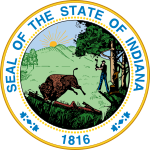Government of Indiana | |
|---|---|
 | |
| Part of | United States of America |
| Constitution | Constitution of Indiana |
| Legislative branch | |
| Name | General Assembly |
| Type | Bicameral |
| Meeting place | Indiana Statehouse |
| Upper house | |
| Name | Senate |
| Presiding officer | Suzanne Crouch, President |
| Lower house | |
| Name | House of Representatives |
| Presiding officer | Todd Huston, Speaker |
| Executive branch | |
| Head of State and Government | |
| Title | Governor |
| Currently | Eric Holcomb |
| Appointer | Election |
| Cabinet | |
| Leader | Governor |
| Deputy leader | Lieutenant Governor |
| Headquarters | Indiana Statehouse |
| Judicial branch | |
| Courts | Courts of Indiana |
| Supreme Court of Indiana | |
| Chief judge | Loretta Rush |
| Seat | Indianapolis |
The government of Indiana is established and regulated by the Constitution of Indiana. The state-level government consists of three branches: the judicial branch, the legislative branch, and the executive branch. The three branches share power and jointly govern the state of Indiana. County and local governments are also constitutional bodies with limited authority to levy taxes, pass legislation, and create and maintain local public infrastructure.
The government of Indiana was first formed in December 1816 and replaced the government of the Indiana Territory. The early government came under criticism beginning as early as the 1820s for having many public offices filled by appointment and lack of delegation of authority to lower officials, requiring state level legislation for things like divorce approval. In 1851 a new constitution was adopted by the state, remedying many of these problems and opening many more office to public election. Significant government reforms were enacted again in 1971 when the state courts were reorganized and new powers were granted to the governor which had historically been a weak institution.
Elections to fill positions in Indiana's government are held on Election Day, with special elections being occasionally held to fill unexpected vacancies. State representatives serve two-year terms, while all other elected state, county, and municipal officials serve four-year terms. Terms are staggered so that elections are held nearly every year, not just in even-numbered years. Most of the positions in the government bureaucracy are filled through the state merit system or the state patronage system.
The government provides a wide range of services including law enforcement, infrastructure construction and maintenance, licensing and registration, tax collection, fire protection, business and utility regulation, utility services, and park and conservation maintenance efforts.
© MMXXIII Rich X Search. We shall prevail. All rights reserved. Rich X Search
